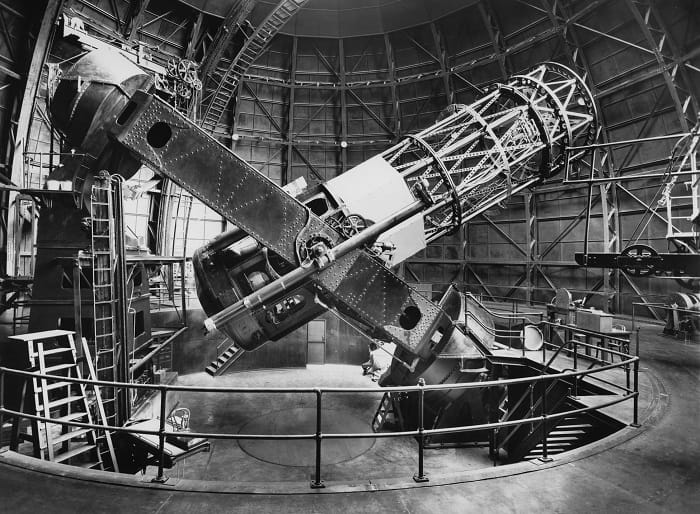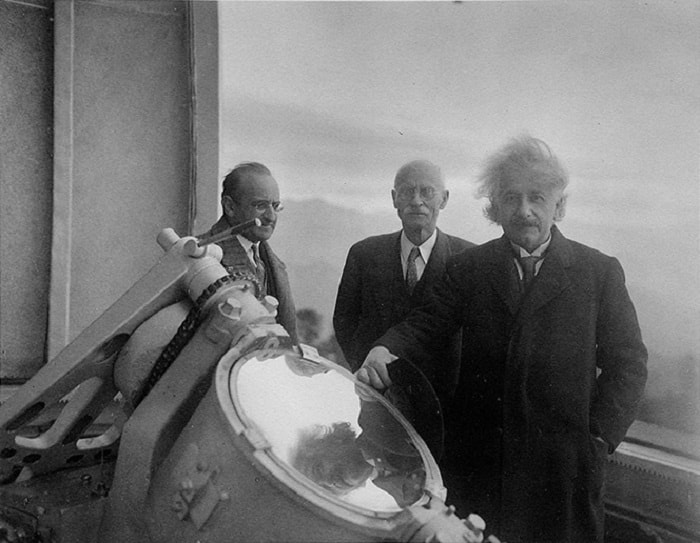Who is Edwin Powell Hubble, and what exactly has he discovered about our universe? Edwin Hubble is undoubtedly one of the greatest astronomers of modern times. He proved that the Milky Way, including our Sun, is an ordinary galaxy and the objects known as “spiral nebulae” are different galaxies. Thus, he made revolutionary changes in our understanding of nature and our understanding of the size of the universe.
Who is Edwin Hubble?
Hubble’s career was very turbulent at first. He was born in Wheaton, Illinois, where he focused on mathematics and astronomy and received a bachelor’s degree in basic science in 1910. He then continued his education in Oxford for three years and was one of the first students to receive the school’s Rhodes scholarship; he did not give up the British attitudes that he adopted here throughout his life. When he returned to the United States, he received a law degree, started teaching at a school in Indiana, and completed his doctorate in astronomy at the University of Chicago.
During the First World War, he served in the US Army and quickly became a Major. Although he never served on an active mission, he would always like to be called “Major Hubble.” After the war, he was called to join the staff of Wilson Mountain Observatory, established near Pasadena, California, in 1919. He stayed there for more than thirty years until his death. He had a happy marriage; his wife Grace was still alive when he died.
He lived in an exciting time in astronomy. The large 100-inch Hooker reflective telescope had just been placed on Mount Wilson. It was not only the largest and most powerful telescope in the world, but it was also unique. Hubble took advantage of it. It had long been known that objects called nebulae were of two different types: some were supposed to be made of prominent gas clouds like M-42 in Orion and others from stars like M-31 in Andromeda. (In the naming of the galaxies, the letter M is used in memory of the French astronomer Messier, who made a catalog for more than a hundred nebula bodies in 1781; M numbers are still in use today.)
Edwin Hubble was sure that the gas nebulae belonged to the Milky Way system, but he was not sure about the star nebulae. Was it possible that they were completely separate from each other and far apart? Of course, they were so far from the Earth that it was not possible to measure their distance with the existing methods at the time. Many, including the M-31, were spirals resembling a pinwheel. There was another distinctive feature: The calculations made elsewhere, usually the Arizona calculations of Vesto Slipher, showed that they were moving away at very high speeds. Slipher used the spectroscopic method for the calculations; as a result, the light from the stellar nebula shifted slightly red, which meant the velocity of departure — a famous Doppler effect.
The cosmic disagreement

Shortly after his arrival at Mount Wilson, Hubble was convinced that the spirals were independent systems. But other famous astronomers disagreed. Harvard College Observatory Manager Harlow Shapley, one of the first to measure the dimensions of our galaxy, was one of those astronomers. Another was the Dutch astronomer Adriaan van Maanen, who had been on Mount Wilson since 1912.
Van Maanen tried to measure the internal velocity of the spirals; he found that the stars within them moved relative to each other, which meant that they could not be as far away as Hubble believed. Because, even in 100,000 light-years, the shift in individual stars would be too small to measure. Therefore, the spirals must be in our galaxy, Van Maanen said. (The disagreement among colleagues at the observatory was also deepened by their dislike of each other.)
Hubble decided to try a completely different method. He would reference the stars known as Cepheid Variable stars. Many stars, including the sun, have shone more or less the same over the centuries, but some are different; some shine and fade at regular, some at unpredictable intervals. The Cepheid Variables, named after Delta Cepheid, the best-known member of the class, have absolute regular periods, ranging from several days to weeks, so that it can always be known how to act; Delta Cepheid, which can be easily seen with the naked eye in the northern hemisphere, has a 5.4-day period—that is, the highest brightness value is reached after 5.4 days. The relation between the true luminosity and the periods of the Cepheids was also known: the luminosity of the star was increasing as the period was extended.
Another Northern Hemisphere Cepheid, Eta Aquilae, has a 7.2-day period and has more luminosity than Delta Cepheid. If we measure the period of a Cepheid, we can find its luminosity and thus its distance, moreover, all Cepheids are very bright, and they can be easily seen from many light-years beyond the galaxy. (Recall that a “light year” is the distance traveled by a ray of light in a year, which is more than 5.9 trillion miles (9.5 trillion kilometers). The most recent measurements give Delta Cepheid’s distance as 982 light-years.)
“Further, faster”

Hubble would now set out to find Cepheids in star nebulae and spiral galaxies. Only the 100-inch telescope on Mount Wilson was powerful enough to do this, and this telescope was at Hubble’s disposal. He soon managed to find what he was looking for. He found Cepheids in many spirals, including the M-31, and showed that they were too far away to take part in the Milky Way. Indeed, these were different galaxies, and the discovery announced on January 1, 1925, changed our view of the Universe. Van Maanen made a completely honest mistake: when measuring the star plates, he did not take into account certain photographic effects that gave the appearance of an unrealistic movement.
Hubble gained fame and continued his research throughout the rest of his life, making important discoveries. His chief assistant was Milton Humason, who began his career as a driver of mules carrying materials to the mountain while the Wilson Mountain Observatory was being built and later became a world-renowned astronomer at the same institution. In particular, they found a link between the distance of a galaxy and the speed of departure: it all depended on the “further, faster” rule.
They discovered that the entire universe is expanding, but to say that all galaxies are moving away from each other was not exactly correct. They form clusters, and each cluster was moving away from all other clusters. Our galaxy and the Andromeda spiral are members of the cluster called the Local Group. They will all eventually collide, but if we are lucky, this will not happen in one billion years.
Universe prior to Edwin Hubble

Today we can see galaxies 10,000 million light-years away, but since we can’t reach 13,700 million light-years away, we can’t yet see the universe right after the moment of the Big Bang when astronomers believe the entire cosmos suddenly formed. For now, we don’t know if we can see that day. Before Hubble began researching Cepheid variables, we believed that the whole universe was the Milky Way.
In addition to the scientific and technical articles, Hubble took the time to write some popular books, the most well-known being The Realm of the Nebulae. He was not the most popular astronomer on Mount Wilson as his colleagues found him stiff and distant. However, according to Patrick Moore, this was not the case: “We came together many times after the Second World War. This young British man who was mainly interested in the moon was very respectful and helpful for an amateur.”
He received almost all the awards that the scientific world could offer. If he did not suddenly die in 1953, he would most likely have received the Nobel Prize in Physics for that year. He will never be forgotten, and of course, it was a good decision to name the first large space telescope orbited by Discovery in 1990 after Edwin Hubble.
Edwin Hubble quotes
“With increasing distance, our knowledge fades, and fades rapidly. Eventually, we reach the dim boundary—the utmost limits of our telescopes. There, we measure shadows, and we search among ghostly errors of measurement for landmarks that are scarcely more substantial. The search will continue. Not until the empirical resources are exhausted, need we pass on to the dreamy realms of speculation.”
“The history of astronomy is a history of receding horizons.”
“Science is the one human activity that is truly progressive. The body of positive knowledge is transmitted from generation to generation.”
“Observations always involve theory.”


